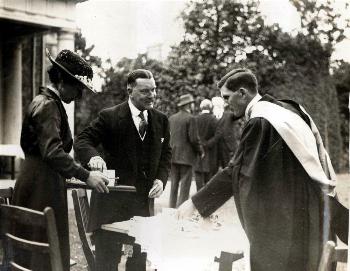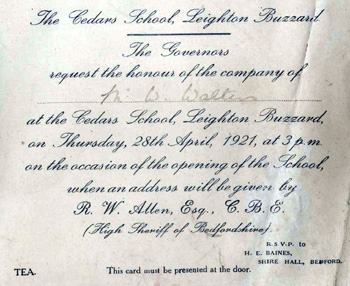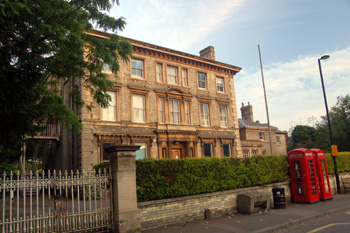The Cedars School Leighton Buzzard

High Sheriff Richard Allen at the opening of the school [AQ11/2/4/3]
About 1920 Bedfordshire County Council, the Local Education Authority, put a case for the purchase of property for the establishment of a secondary school for boys and girls at Leighton Buzzard to counsel [E/SA1/1/3]. The case noted that The Cedars was on the market for £4,000 "this sum excludes the warehouse in Bridge Street and the strip of land on the West side of the Mill Stream". Given that this land was not included the Council offered £3,750. On 24th January, however, the Council wrote accepting the price of £4,000 for the building but received no reply. On 6th February the agents again asked whether the Council were prepared to buy the house before it was auctioned. On 17th February the Council was informed that the property had been sold at auction for £4,500. The Council therefore wished for counsel's opinion on whether the correspondence formed a binding contract to which the Council could hold the agents. The outcome of this advice has not survived but whatever it was the Council did purchase The Cedars and opened the school in 1921.

Invitation to the opening of The Cedars in 1921
The Bedfordshire Times reported at some length on the School [AQ11/2/4/3]: "The Cedars School, which has been founded by the Bedfordshire Education Authority, in conjunction with the neighbouring county of Buckingham, to meet the long-felt needs of Leighton Buzzard, Linslade and the surrounding district for secondary education, was formally opened on Thursday by the High Sheriff of Bedfordshire, Mr.R.W.Allen C.B.E. A more glorious day for the inauguration of the school could not have been chosen. In the bright sunshine the spick and span from rooms and the ancient gardens, which have been restored to their former neatness, charmed both the privileged visitors and the parents of the pupils who were invited to hear the opening speeches, as well as scores of townspeople who were permitted to view the school and gardens during the evening".
"Mr.R.Richmond, chairman of the School Governors, presided over the opening ceremony, and was supported by the High Sheriff and his Chaplain, Rev.C.F.Farrar, the Head Master (Mr.F.Fairbrother), Mr.H.E.Baines and Mr.C.G.Watkins, Directors of Education for Beds and Bucks, Mrs.Johnstone Harris, Miss Pease, Miss Walmsley, Mr.J.R.T.Tarver, Rev.L.E.Lydekker, Mr.J.H.Green, Mr.G.Chapman, Mr.W.E.Wallace and Mr.H.E.Herington (Governors). The room was crowded with representatives of the county and local authorities in Beds and Bucks, and again an hour later with parents who were also addressed by the High Sheriff and the Head Master".
"The Chairman expressed regret that the School Assembly Hall was not large enough to hold everybody they would have liked to see there that day and said he hoped the time was not far distant when the Governors would be justified in converting the large building near the stables into a hall. He congratulated the inhabitants of Leighton Buzzard and Linslade upon the opening of the school, and was very pleased Bucks had been included in the scheme. The two counties had not always pulled well together, but there was no reason this venture should not be a success. The agreement between them was a very simple one of four clauses [E/SA1/1/4]. To some of his solicitor friends it might seem too short - (laughter) - but he thought it would work well. The cost of the school was to be divided between the two counties in proportion to the number of pupils from each county at the end of the school year. Six Governors had been appointed for Beds, four for Bucks and two others had been co-opted. The school would be open on Tuesday with over 100 pupils, roughly 75 per cent from Beds and 25 per cent from Bucks. There were no free places this term, but an examination was to be held on May 25th for free places for the term commencing September next. A number of Junior County Scholarships would also be granted by the Beds Education Authority".
"As most of them knew, a secondary school in Leighton Buzzard was no new idea. The 1895 report of the Royal Commission on secondary education said: "Leighton Buzzard is an even worse case as regards secondary education then Luton, possessing no higher grade school and no public continuation classes". The report concluded by expressing a doubt whether co-operation between Beds and Bucks would be at all easy (laughter). They had got over that difficulty. A definite scheme was considered in 1906 after the Institute buildings had been taken over by the Urban District Council and the greater part of them leased to Beds Education Authority. It was suggested that they should use the premises with the addition of a new building containing at least four class rooms, but the scheme fell through because it was not considered satisfactory enough to warrant the expense of the proposed new building. As many of them knew, the question was not allowed to rest, many of the parents of prospective pupils being very anxious that something should be done. In 1912 a joint committee was appointed by Beds and Bucks Education Authorities to consider the question. No definite progress was made in 1913, and the war was quite sufficient reason for the question being postponed until 1919, when a list was sent to Bedford from Leighton Buzzard, of over a hundred parents who hoped to be able to send their children to a secondary school. In January 1920, another joint committee of the two counties met and came to an agreement, and the Beds Education Authority were fortunate enough to secure that house and grounds at a price, which a Buckinghamshire friend had told him was just the cost of four cottages he had built (laughter). The house had been easily converted, and the stables gave ample accommodation for carpentry and cookery classes. The large building he hoped would some day make a fine hall for meeting of pupils and parents, and also for concerts. They had been fortunate in the appointment of staff, and he had every confidence that the pupils could safely be left to Mr.Fairbrother and his assistants (applause)".

Girls cookery class at Cedars School about 1930 [Z50/72/202]
The Education Act 1944, which came into effect in 1946, created a two tier system of secondary education. The best 25% of pupils taking an examination at age eleven went to grammar schools and were taught an academic curriculum intended to allow them to go to university. The remainder of pupils went to secondary modern schools and were taught a more skills based curriculum intended to fit them for work. The Cedars became a grammar school.
In 1968 the Secretary of State approved a comprehensive reorganisation of schools by the Local Education Authority, Bedfordshire County Council. This did away with selection, all pupils attending similar schools, teaching the same curriculum, based solely on age. Children aged 5 to 9 attended lower schools, those aged 9 to 13 went to a middle school and those aged 13 to 18 attended an upper school. The council affirmed its support for the scheme in 1969 and again in 1970 and in 1974 the reorganisation reached the Leighton Buzzard area. The Cedars, therefore, became an Upper School but, as the Church Square premises were too small, moved to new purpose built buildings on the old Cedars playing fields in Linslade in 1973. The old Cedars premises became Leighton Middle School.

The former premises of The Cedars in June 2008
Sources
- E/SA1/1/3: Case for the opinion of counsel on the purchase of property to establish a secondary school in Leighton Buzzard: 1920s;
- SGM22/1-5: School Governors' Minutes: 1920-1973;
- EV75: committee papers for governors meetings: 1920-1923;
- SDLeightonBuzzardCedars1/1: Governors; Committee minute book: 1920-1928;
- E/PS1/1/1: Local Education Authority correspondence with Harpur Trust including figures for free places offered to pupils at Cedars: 1921;
- E/SA1/1/4-5: agreements providing for admission of children from Bedfordshire: 1921;
- EV62/3 and 65: correspondence regarding various prizes: 1921-1946;
- PCToddington2/4/4/5: invitation to the school opening: 1921;
- UDLLP2/21: plan for games pavilion in Mentmore Road, Linslade: 1924;
- CTM17/62: mortgage for playing fields: 1925;
- CTM17/71: various mortgages: 1925;
- CCE63: deeds to land in Linslade acquired as playing fields: 1925-1991;
- CTM17/77: mortgage: 1927;
- CRT130LEI29: stone laying and speech day programme: 1928;
- CTM17/85: mortgage for cooking range: 1928;
- CTM17/28/1-3: correspondence regarding mortgage: 1929;
- Z55/3/1-20: twenty photographs of the school: c.1930;
- Z55/1/42-43: photographs: c.1930;
- Z50/72/155: photograph: c.1930;
- Z818/71-79: photographs of the grounds: c.1930;
- CS/SPL943: J.H.Green Trust Deed: 1936-1937;
- Z53/72/1-2: Library photographs: 1961;
- CA2/59: acquisition of property in Bridge Street: 1965;
- CA8/156: building maintenance file: 1966-1973;
- PCAspleyGuise26/1: notice regarding enlargement of school: 1967;
- E/CU1/1/1: policy file on high/upper school provision and curriculum including report on science teaching at Cedars: 1967;
- CA2/564: extension building file: 1968-1974;
- PY/PH18/1-2: exterior photographs: 1969;
- CA711: building file for conversion to a middle school: 1974-1979